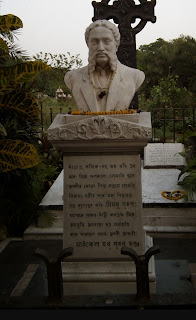Movie Ad Poster ‘Tiias Akti Nodir Nam’ (directed by Ritwik Ghatak) – A stark portrayal of women’s perennial struggle for survival in Bengal's riverine settlements
It’s a curse to be born a woman. Yet ”One is not born, but rather becomes, a woman.”, once Simone de Beauvoir echoed. No eye bows are raised if the struggling illiterate parents marry off theirs ‘not yet come of age’ daughters to face the unknown outside world. The Ad of the movie ‘Titas Akti Nadir Nam’ successfully portrays the insensitivity of the society towards fairer sex ravaged by unwelcome events beyond their control.
In the image frame, the dominant brush colour is depressingly pinkish-white with black as the contrast. The twin colours do reflect a future of despair. The image prominently shows the face of a young rustic woman. The anguish is distinctly visible on her face, reflects nothing but gloom. The tears rolling down on one of her cheeks, warn of an impending calamity. The wrinkled eyebrows and the anguish on her forehead tell her own story to the viewers.
How far readers would agree with me that the portray reflects a universal struggle of the fairer sex since the dawn of our civilization, for a better safer world, on equal footing!
The story unfolds with the marriage of a young fisherman with an underage teenage girl by sheer accident in a distant village on the bank of Titas. After their wedding night, while returning in own boat, in the dead of night, the bride is kidnapped on the river. On losing his wife, the lad becomes mad. Meanwhile, his young bride fights with the bandits, and jumps into the river. Later, she is found by another group of fishermen as she lay unconscious far away on the bank of Titas. But the trouble of the bride continues as she cannot remember hubby’s name or any other details except the name of the village where the hubby lived.
On closer scrutiny, the Image of the woman on the poster of ‘Titas Ekti Nadir Nam’ reiterates that in the male-dominated society woman has to suppress her voice, lest they get unjustly vilified.
Then how to distinguish whether it was only a woman’s lone struggle or of the whole fishing community or of the womenfolk of the village. The image does not inspire confidence that the struggle is for the whole community as the image portray the joy of the festive boat-racers while the world of the lady is painted with a colour of gloom. But does it reflect as the struggle of the fairer sex or a solitary case of an exception? The image does not offer any solution.
However, the method of filmmaking does emphasize that art is not meant to be propagandist, Although the title of the movie is ‘The River Named Titas’ (‘Tiias Akti Nodir Nam’), drawing a feeling that it is a tale of a river and river is the key around which the movie revolves, yet the poster, interestingly, does not show any image of the river that is central to the story. The movie is as much about the lost-bride as about the village-widow Basanti and of Ananta, the child of the dead bride, but these characters have not been introduced into the Ad Poster. being subtle. The poster carries the image of a crying rustic woman that perhaps aptly describes the struggle of millions of female folks who are brought up in a discriminatory while offering all privileges to the male child. The women are the burden of their parents and the burden of the village when they become a widow or forced widow, as in the movie. Millions of females die before they are born, after sex determination. In the job market and other avenues, the women are paid less than their male counterpart. The patriarchal society continues to subjugate women’s freedom. Just like the central character of the story, the bride, commits suicide.
Then the misfortune strikes the village, when the river dries up, turning each hut penniless. The womenfolk begin to move out of the village for earning to make the family survive and a few fall prey to the most primitive trade. The folk songs of the river, the rituals of thousands of years of riverine civilization get lost with the death of the river. In the last scene of the movie, a dying woman digs deep with her hand on the dead river sand-bed to quench her thrust with last few drops of water. The river, perhaps, has changed its track so has the struggle of women become gloomier.
A few Critics have opined that the story too loosely connects multiple plots and too many characters incoherently brought into the movie instead of having a central plot. And that certain scenes could have been more realistic. However, on closer scrutiny, the same allegation has been discounted by the other critics of repute like poet Nabarun Bhattacharya, who counters that a gap in perception of the civilizational culture and of understanding the deep-rooted social rituals could have led to believe that certain scenes are not realistic, though each one is a sincere painstaking portrayal of women around the fictional river “Titas”.





Comments
Post a Comment